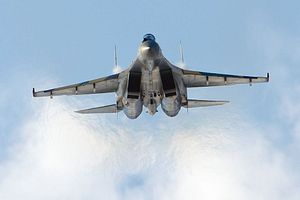The Chinese People’s Liberation Army-Air Force (PLAAF) is slated to receive the first four out of 24 Russian-made Sukhoi Su-35 multirole fighter jets, the governor of Khabarovsk Krai, a federal subject located in the Russian Far East, said in a speech during the opening of a new aircraft production plan on September 15, according to local media reports.
From 2016 to 2018 the Komsomolsk-on-Amur Aircraft Production plant will deliver 24 Su-35 combat aircraft to China, the governor said. China first showed interest in one of Russia’s most modern combat aircraft in 2008. Negotiations over the Su-35 deal began in 2011. A preliminary agreement was reached in 2012 with a final sales contract signed in November 2015.
“The Su-35 (NATO reporting name: Flanker-E) is a Fourth++ generation, twin-engine, highly maneuverable multirole fighter jet powered by two AL-117S turbofan engines. The Russian aircraft’s powerful turbofan engine is also the most likely reason why China is interested in acquiring Su-35 fighters,” I previously explained.
One of the reasons for China’s interest in the Su-35 is its AL-117S turbofan engine. Russia has repeatedly refused to sell the engine as a stand-alone product, which left the PLAAF with little choice but to acquire the entire aircraft. The Chinese military aviation industry is still struggling with designing and building an engine for its new fifth-generation stealth fighter prototype, the Chengdu J-20.
“The most advanced Chinese-made military turbofan currently in use is the WS-10, which, however, also underperforms, according to some reports,” I explained elsewhere (See: “Confirmed: China Buys 24 Advanced Fighter Jets From Russia”). Both of the PLAAF’s new fifth-generation fighter jet prototypes–the Chengdu J-20 and Shenyang J-31–are equipped with older Russian-made jet engines, the former with the Saturn AL-31 the latter with the Klimov RD-93.
China’s aviation industry has been pushing hard to domestically develop and build high-performance turbofan engines. In August 2016, Beijing announced that it set up a new state-owned aircraft engine maker to accelerate the development of new jet engines. China, for example, is currently working on the WS-13 Taishan turbofan, a derivative of the Russian Klimov RD-33 turbofan.
Obtaining the Su-35 combat aircraft and its AL-117S turbofan engine would be a major boon for China’s aviation industry given that the engine could be reverse engineered. Next to the powerful engine, the Su-35, with its air refueling capability and its ability to carry external fuel tanks, will provide the PLAAF also with greater control of the skies over China and adjacent waters including the East and South China Seas.
































